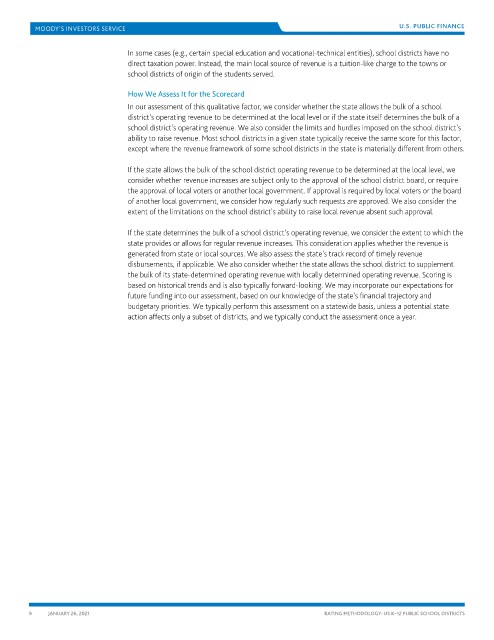Page 1643 - draft
P. 1643
U.S. PUBLIC FINANCE
In some cases (e.g., certain special education and vocational-technical entities), school districts have no
direct taxation power. Instead, the main local source of revenue is a tuition-like charge to the towns or
school districts of origin of the students served.
How We Assess It for the Scorecard
In our assessment of this qualitative factor, we consider whether the state allows the bulk of a school
district’s operating revenue to be determined at the local level or if the state itself determines the bulk of a
school district’s operating revenue. We also consider the limits and hurdles imposed on the school district’s
ability to raise revenue. Most school districts in a given state typically receive the same score for this factor,
except where the revenue framework of some school districts in the state is materially different from others.
If the state allows the bulk of the school district operating revenue to be determined at the local level, we
consider whether revenue increases are subject only to the approval of the school district board, or require
the approval of local voters or another local government. If approval is required by local voters or the board
of another local government, we consider how regularly such requests are approved. We also consider the
extent of the limitations on the school district’s ability to raise local revenue absent such approval.
If the state determines the bulk of a school district’s operating revenue, we consider the extent to which the
state provides or allows for regular revenue increases. This consideration applies whether the revenue is
generated from state or local sources. We also assess the state’s track record of timely revenue
disbursements, if applicable. We also consider whether the state allows the school district to supplement
the bulk of its state-determined operating revenue with locally determined operating revenue. Scoring is
based on historical trends and is also typically forward-looking. We may incorporate our expectations for
future funding into our assessment, based on our knowledge of the state’s financial trajectory and
budgetary priorities. We typically perform this assessment on a statewide basis, unless a potential state
action affects only a subset of districts, and we typically conduct the assessment once a year.
9 JANUARY 26, 2021 RATING METHODOLOGY: US K–12 PUBLIC SCHOOL DISTRICTS

